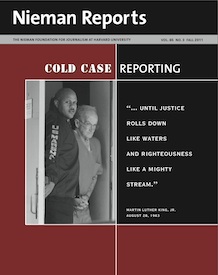Editor’s Note: Our sister publication Nieman Reports is out with their Fall 2011 issue, “Cold Case Reporting,” which focuses on process of revisiting old investigations to tell new stories. Over the next few days, we’ll highlight a few stories from the issue — but go read the whole thing. In this piece, Jean Marie Brown writes about her year-long study on the exclusion of minority coverage in online news.
Legacy news organizations have struggled for decades to widen their coverage to include people of color in all aspects of their lives. There are the ubiquitous A-list celebrities, of course, and the crossover musicians and the athletes, and those stories with an emotional punch that transcend the usual norms, but neither print nor broadcast media have consistently portrayed minorities in all facets of American life and culture.
 I remember once telling a fellow editor that I had stopped reading a certain section of the paper because I so rarely saw my life or myself — a working black mother — represented in its stories or photographs. Through the years the excuses I heard for these lapses ranged from “we just didn’t think about it” or “we didn’t have anyone to send” to “there was no space” or “we had to make deadline.”
I remember once telling a fellow editor that I had stopped reading a certain section of the paper because I so rarely saw my life or myself — a working black mother — represented in its stories or photographs. Through the years the excuses I heard for these lapses ranged from “we just didn’t think about it” or “we didn’t have anyone to send” to “there was no space” or “we had to make deadline.”
But the web is supposed to be different, right? Space is unlimited. The ability to aggregate copy gets around staffing concerns. The institutionalized habits (and excuses) that hamstrung the legacy newsrooms aren’t part of online culture. Couple this with the notion that we’re said to be living in a post-racial society and the result should be rich, vibrant reporting that represents the life experiences of all Americans. It should not be coverage that is stratified by class, race, geography, generation and gender.